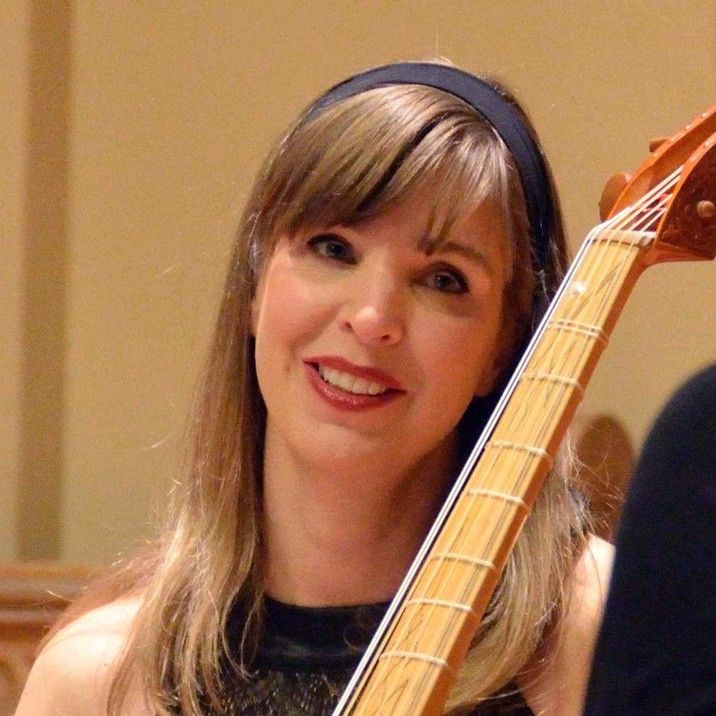What is a Viol?
Viol is an English term for a specific kind of bowed instrument. Viols are made in all sizes, from very small to very large. As a result, one may refer to a ‘viol family’ since all the sizes share similar traits (like six strings, the use of frets, etc). In Italian, the viol is called the “viola da gamba” (which means “leg-viol”) since the instrument is always played in a vertical position, with the larger ones held between the legs, and the smaller ones placed in the lap.
How is the viol related to the cello?
Viols are not related to the violin family (violins, violas and cellos). Both viol and violin families were in use concurrently during the 16th, 17th and 18th centuries and have separate construction features, as well as different playing techniques and repertoires. If a comparison must be made, viols are most closely related to the medieval guitar, called the “vihuela.”
Music for Viols
There is a huge amount of music that was written for the viol, both as a solo instrument, and within a chamber music context. The largest body of music for viols was conceived for a whole ensemble of viols, which is called a “consort.” Composers wrote for the viol from c1480 until c1800, and then again in the 20th and 21st century. Viols are not orchestral instruments; most of their music was intended for performance in small spaces like peoples’ homes, or in church.
Consorts of viols could be made up of any number of instruments and players. In principle, though, viol consort music tends to be dominated by ‘large bodied’ instruments. As a result, viol consorts look and sound very different from the modern string quartet, which is characterized by two violins—small instruments. Viol consort composers tended to favour the inner and lower voices – alto and tenor, even bass ranged instruments.
Sizes of the Hart House Viols
300 years ago, players didn’t have separate names for each size member of the viol family. Nowadays, we refer to specific sizes by names that describe their function in an ensemble (treble, tenor, bass), and these names carry an implication to a modern player about the precise body size and how strings are tuned.
The two smallest instruments (Guersan and Bertrand) are called “pardessus,” which is the smallest form of the viol family. Pardessus sometimes had five, and other times, six strings. This size viol was not used in ensembles, but instead favoured in France and Francophile areas (like Quebec) as a solo instrument for middle and upper class women who wished to play violin repertoire.
The largest of the Hart House instruments is called a “bass viol” and with six strings, its range covers that of both the cello and the viola. From the early 17th century, this size became the preferred instrument for solo viol music, and increasingly, the preferred ‘continuo’ instrument playing bass lines in an ensemble. Occasionally bass viols have seven strings (in which case the extra string is on the bottom, extending the low range of the instrument).
The middle three instruments in the Hart House collection are all “treble viols” although the largest one by John Rose Jr. has a very long neck (not original) and is therefore tuned lower than the others, as a “tenor viol” in G.
In modern parlance, there is no such thing as an “alto viol,” but during the early 20th century (before much research had been done), large trebles and small tenors were sometimes labeled by that name.
The Makers
Each instrument was made by a different luthier (builder), and the Hart House collection is outstanding because it represents six of the most renowned viol makers of all time. Few museums in the world can boast viols by these makers, let alone instruments that are in playing condition!
If the viols are in playing condition, why are they locked away in a glass prison?!
In the 1990s, Hart House took steps to safeguard and conserve this rare and valuable collection. The special humidity-controlled display case allows the instruments to be seen and appreciated by a wide public on a day-to-day basis, while protecting them from the deleterious effects of the environment. At the same time, Hart House still permits the instruments to come out of the case for use in special projects.
Are the Viols Really in Playing Condition?
Yes, the viols are all in good health, and inspected and played regularly. Any loose strings are simply an indication that a peg has ‘slipped’ and needs to be retightened. All other marks (old cracks, etc) are just signs of the instruments’ old age.
Who Plays Viols in the 21st Century?
The 20th century saw a resurgence of interest in the viol. Along with the recorder, harpsichord and singing, playing the viol has returned to its true historical place as being a wonderful pastime for adult amateurs; lovers of the viol are nowadays found in many communities across North America. As a result, there is quite a demand for lessons and workshops, there are numerous local and regional ‘societies’ for the viol, and access to musical editions, recordings and instrument rentals is also relatively easy.
It is not an exaggeration to say that fully 85-90 % of the viol-playing community is ‘amateur’—the number of individuals who have trained at conservatory and/or who play the viol professionally is extremely small. Most university programs do not offer the viol as a possible instrument of study. In the Toronto area, there are only a handful of individuals who received university level training on the viol who play professionally. But several of the more experienced amateurs also perform in public whenever possible. The extended Toronto area boasts approximately 100 adult amateurs, who play the viol at (greatly) varying degrees of competence.





